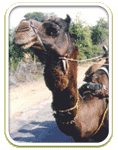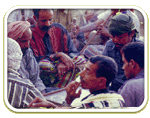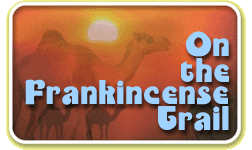 |
 |
 |
|
|||
|
On The Frankincense Trail 
First, some clarifications. The Arabian camel or dromedary, stands about seven feet at the shoulder and has only one hump, whereas the bactrian camel, it's shorter, stockier Asian cousin is the one with two. Secondly, camels do not store water in their humps, which are primarily made of fat.. Yes, fat, which they can live off of for several days, if need be, on desert treks of 100 miles or more. Another secret to the camel's endurance is its unenviable diet of thorny, desert scrub, which not only provides sustenance but moisture. Throw in some broad, callused feet that can slog through scorching dunes and a pair of sandstorm-resistant, rather endearing, human-like eyelashes, and you've got one of nature's most skillfully adapted creatures in one of her most brutally inhospitable environments. ...places like southern Jordan's Wadi Rum, where Lawrence of Arabia was filmed and nomadic Bedouin tribesmen still travel by camel from campsite to campsite, as did I, even though some may also have a pickup truck parked next to their tent.
Tom: "What does he ask?" Beneath the shade of a black, goat-hair tent, my host, Ogla Joma, tells me his family keeps camels for their milk, which they sell, and their hair, which provided the raw material for the rug I was sitting on. This sort of commercial reliance on camels dates back some 4,000 years, when the animals were first domesticated... a true benchmark in the history of the frankincense trade which, up until that time, had been local, limited by its dependence on donkeys that were incapable of traveling great distances through the desert. And as the great caravans... some numbering a 1,000 animals or more... stretched for miles across the desert, they left civilizations in their wakes... civilizations that might never have existed had it not been for the trade and the camels that supported it. 
McColl: "The trade and the merchants bring cultures together." Robert McColl is a geography professor at the University of Kansas whom I met up with in Saudi Arabia and who specializes in how cultures in arid climates develop trade.
McColl: "One has to think it has the equivalent of Wild West rodeo days when all these people came in from all these cultures, bringing all these different products, saying 'Okay I'll give you three pearls and two bags of incense for a piece of lapis lazuli' or something." Another legacy of these colorful marketplaces... the old section of the Yemeni capital of Sana'a for example... are the Caravanseri. These often rectangular, two-story buildings with shops and storehouses facing an inner courtyard still survive in many cities throughout the Middle East, and were specifically built, says World Bank restoration architect Bruce Polluck, as loading docks for camel caravans.
Polluck: "The animals in many cases would come right inside the building. They would unload the animal, then they'd take the animal out to a yard somewhere farther out where they would be watered and kept during the period of their stay." In the Saudi Arabian Red Sea port city of Jeddah, preservation official Sami Saleh Nawar gives tours of the Naseef House, built in the 19th century by merchants who mandated that its stairwells be wide enough to accommodate camels. So important were the animals to the local economy, said Sami, that they were even protected, by law, from their... competition. 
Sami: "You know the first amendment in driving in Saudi Arabia. It says don't make too much horn so the camel caravan, uh, the camel not run away. Considering all they've done for civilization, it seems ungrateful, if not traitorous, to even mention one more popular use for camels here in southern Oman and throughout the Middle East.
Verde: "All right, now which one is this, is this the grilled one?" Just for the record, barbecued or fried, camel meat tastes like a cross between pastrami and, you guessed it, chicken. On the frankincense trail in the Sultanate of Oman, I'm Tom Verde for The Savvy Traveler Air transportation and accomodations in Oman provided by the Oman Ministry of Information. Air transportation and accommodations in Saudi Arabia provided by Saudi Arabian Airlines. Air transportation and accommodations in Jordan provided by Jordan Tourism Board.
{ On the Frankincense Trail: Part One | Part Two | Part Three | Part Four | Part Five }
|
 | American Public Media Home | Search | How to Listen ©2004 American Public Media | Terms of Use | Privacy Policy |
